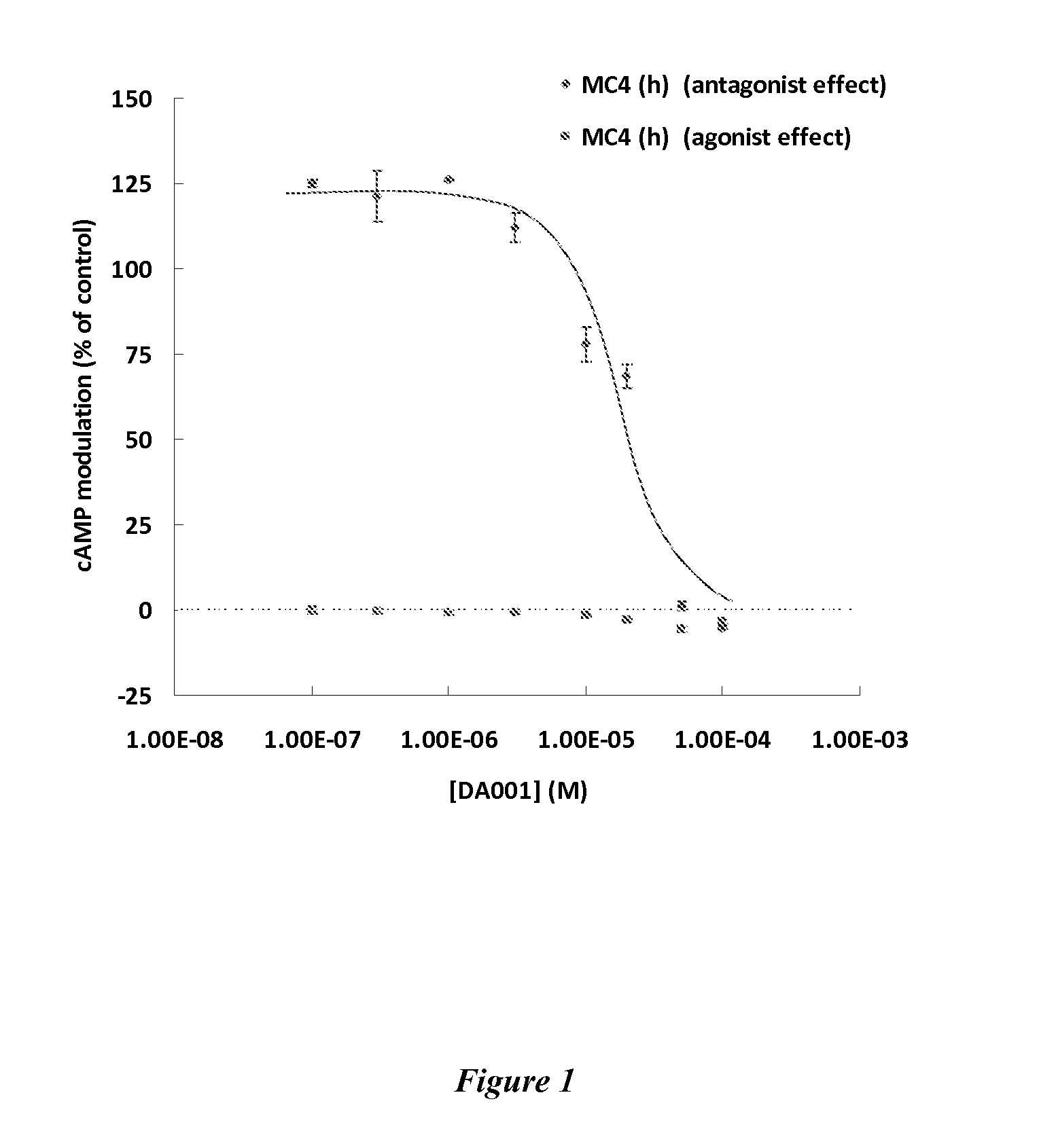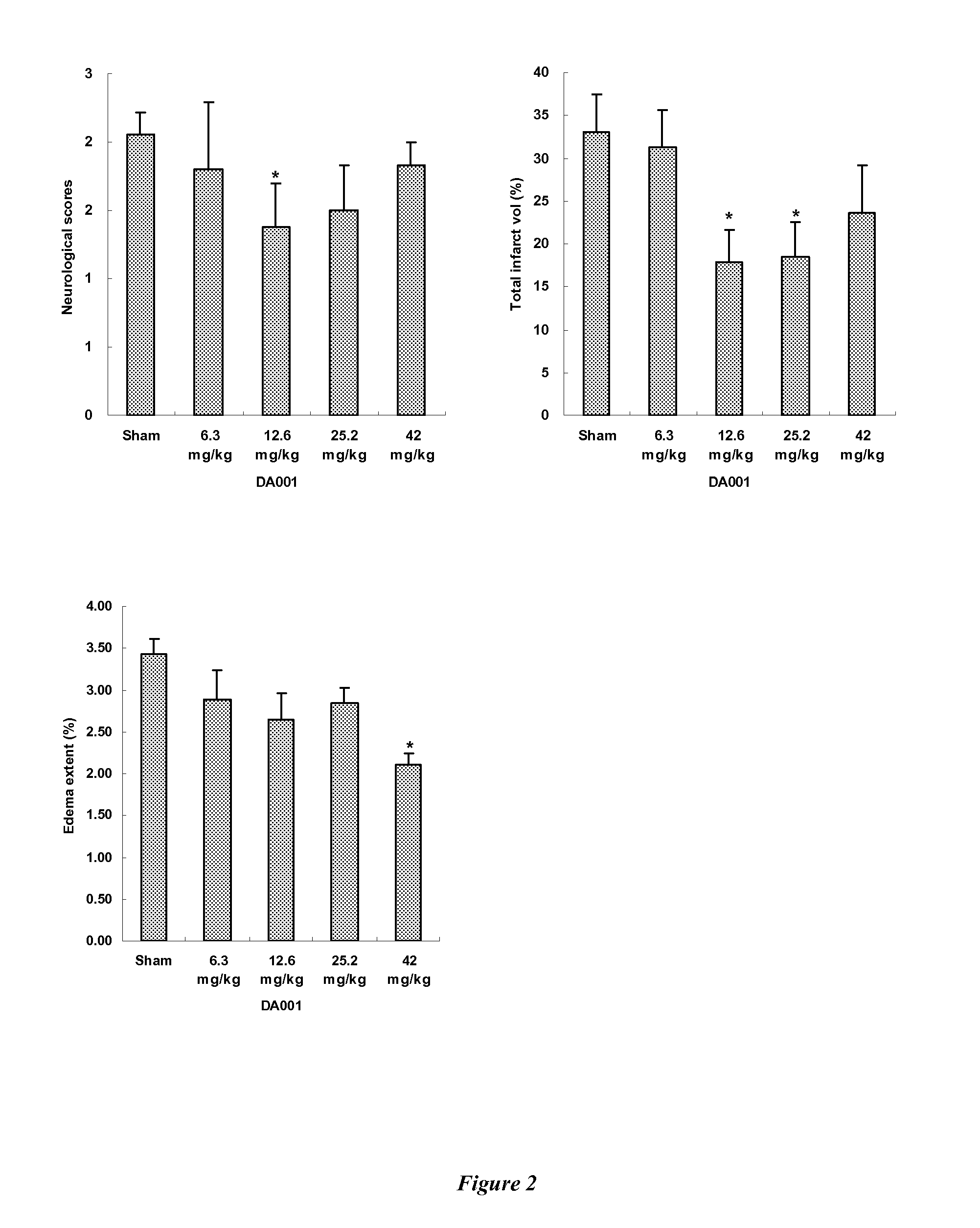Triterpenoid compounds and methods of use thereof
a technology of triterpenoids and compounds, applied in the field of prostaglandins, can solve the problems of attenuating neurological deficits in eae mice, few therapeutic agents are known to be effective in improving the symptoms of eae, etc., and achieves the effects of suppressing bacterial and allergen-induced inflammation, and increasing the expression of pro-inflammatory stat proteins and cytokines
- Summary
- Abstract
- Description
- Claims
- Application Information
AI Technical Summary
Benefits of technology
Problems solved by technology
Method used
Image
Examples
example 1
Preparation of 3,23-Diacetoxy-betulinic amide (DA048)
Synthesis of 3,23-diacetoxy-betulinic acetic anhydride (1)
[0248]3,23-Diacetoxy-betulinic acetic anhydride: A mixture of 23-hydroxy-betulinic acid (1.0 g, 2.12 mmoL) in 20 mL of pyridine and 10 mL of acetic anhydride was stirred at room temperature for 48 h. The mixture was diluted with 50 mL of ethyl acetate, washed with 10% HCl (30 mL×3), brine (30 mL×1), dried over sodium sulfate, filtered and concentrated under reduced pressure. The resulting residue was purified by column chromatography on silica gel column, eluting with 1% methanol in methylene chloride to provide the desired product (1.24 g, 2.08 mmoL, 98%) as a white foaming solid. 1H NMR (300 MHz, CDCl3) δ 4.77 (dd, J=11.1, 4.5 Hz, 1H), 4.74 (s, 1H), 4.61 (s, 1H), 3.84 (d, J=11.4 Hz, 1H), 3.69 (d, J=11.4 Hz, 1H), 3.03-2.95 (m, 1H), 2.29-2.22 (m, 2H), 2.11 (s, 3H), 2.07 (s, 3H), 2.02 (s, 3H), 2.01-1.95 (m, 1H), 1.68-0.99 (m, 21H), 0.97 (s, 3H), 0.93 (s, 3H), 0.88 (s, 3H), 0...
example 2
Preparation of 3,23-diacetoxy-betulinic 2-hydroxyethyl amide (DA049)
[0250]To a solution of 3,23-diacetoxy-betulinic acetic anhydride (52 mg, 0.087 mmoL) dissolved in 2 mL dry methylene chloride, was added oxalyl dichloride (76 μL, 0.87 mmoL) under nitrogen. The mixture was stirred at room temperature for 2 h and then concentrated under reduced pressure. A solution of ethanolamine (26 μL, 0.43 mmoL) in 2 mL dry methylene chloride was added and the mixture was stirred at room temperature overnight. Aqueous workup followed by purification by column chromatography on silica gel column, eluting with 50% ethyl acetate in petroleum ether provided the desired product (52 mg, 100%) as a white solid. 1H NMR (400 MHz, CDCl3) δ 6.22 (t, J=7.1 Hz, 1H), 4.77 (dd, J=11.4, 4.6 Hz, 1H), 4.74 (s, 1H), 4.60 (s, 1H), 3.84 (d, J=11.4 Hz, 1H), 3.69 (d, J=11.4 Hz, 1H), 3.70 (s, 2H), 3.52-3.33 (m, 2H), 3.19 (br s, 1H), 3.10 (dt, J=11.1, 4.6 Hz, 1H), 2.51-2.39 (m, 1H), 2.10-1.90 (m, 2H), 2.07 (s, 3H), 2.02 ...
example 3
Preparation of 3,23-diacetoxy-betulinic methyl amide (DA050)
[0251]To a solution of 3,23-diacetoxy-betulinic acetic anhydride (54 mg, 0.090 mmoL) dissolved in 2 mL dry methylene chloride, was added oxalyl dichloride (78 μL, 0.90 mmoL) under nitrogen. The mixture was stirred at room temperature for 2 h and then concentrated under reduced pressure. A solution of methylamine in ethanol (33% wt, 112 μL, 0.90 mmoL) was added and the mixture was stirred at room temperature overnight. Aqueous workup followed by purification by column chromatography on silica gel column, eluting with 25% ethyl acetate in petroleum ether provided the desired product (51 mg, 100%) as a white solid. 1H NMR (400 MHz, CDCl3) δ 5.70 (br s, 1H), 4.77 (dd, J=10.6, 4.6 Hz, 1H), 4.74 (s, 1H), 4.59 (s, 1H), 3.85 (d, J=10.6 Hz, 1H), 3.68 (d, J=10.6 Hz, 1H), 3.14 (dt, J=10.6, 4.6 Hz, 1H), 2.79 (d, J=4.6 Hz, 3H), 2.52-2.40 (m, 1H), 2.07 (s, 3H), 2.05-1.87 (m, 2H), 2.02 (s, 3H), 1.80-0.75 (m, 22H), 1.68 (s, 3H), 0.96 (s, 3...
PUM
| Property | Measurement | Unit |
|---|---|---|
| density | aaaaa | aaaaa |
| wavelength | aaaaa | aaaaa |
| thickness | aaaaa | aaaaa |
Abstract
Description
Claims
Application Information
 Login to View More
Login to View More - R&D
- Intellectual Property
- Life Sciences
- Materials
- Tech Scout
- Unparalleled Data Quality
- Higher Quality Content
- 60% Fewer Hallucinations
Browse by: Latest US Patents, China's latest patents, Technical Efficacy Thesaurus, Application Domain, Technology Topic, Popular Technical Reports.
© 2025 PatSnap. All rights reserved.Legal|Privacy policy|Modern Slavery Act Transparency Statement|Sitemap|About US| Contact US: help@patsnap.com



